The SaaS market is fiercely competitive, and in a space where paid acquisition gets costlier every year, organic visibility and authority often determine who thrives and who fades out. SaaS SEO, if done right, becomes your long-term growth lever. A well-crafted SaaS SEO strategy consistently attracts qualified users to your website without relying solely on ads, building both authority and trust over time.
In this guide, I will share proven strategies for scaling your SaaS SEO, from keyword research and content planning to ROI-driven backlink building, illustrated with real-world examples of brands that successfully implemented these tactics.
What Is SaaS SEO?
SaaS SEO, or search engine optimization for software-as-a-service companies, is the practice of optimizing your website to drive visibility and engagement across the entire buyer journey, i.e., from awareness to signups and renewals.
Unlike traditional SEO, which often targets broad informational queries, SaaS SEO focuses on intent-driven, feature-specific searches that attract and convert users into paying subscribers.
With AI-powered overviews and entity-based optimization, ranking today is no longer just about targeting the right keywords. It also requires building context, demonstrating expertise, and earning authority.
In other words, SaaS brands need content and link-building strategies that AI and search engines can evaluate, trust, and reward. This ensures both visibility and sustainable growth.
Why Do SaaS Brands Need SEO?
SEO is one of the most cost-effective acquisition channels for SaaS companies, and its benefits compound over time. Here’s why it’s essential:
- Reduce customer acquisition costs (CAC)
Organic traffic consistently delivers stronger ROI than paid channels. According to FirstPageSage, the average return on ad spend (ROAS) for B2B SaaS is 8.75x for SEO, compared to 1.7x for paid search. This means SEO delivers over 4x higher ROI and significantly lowers long-term acquisition costs.
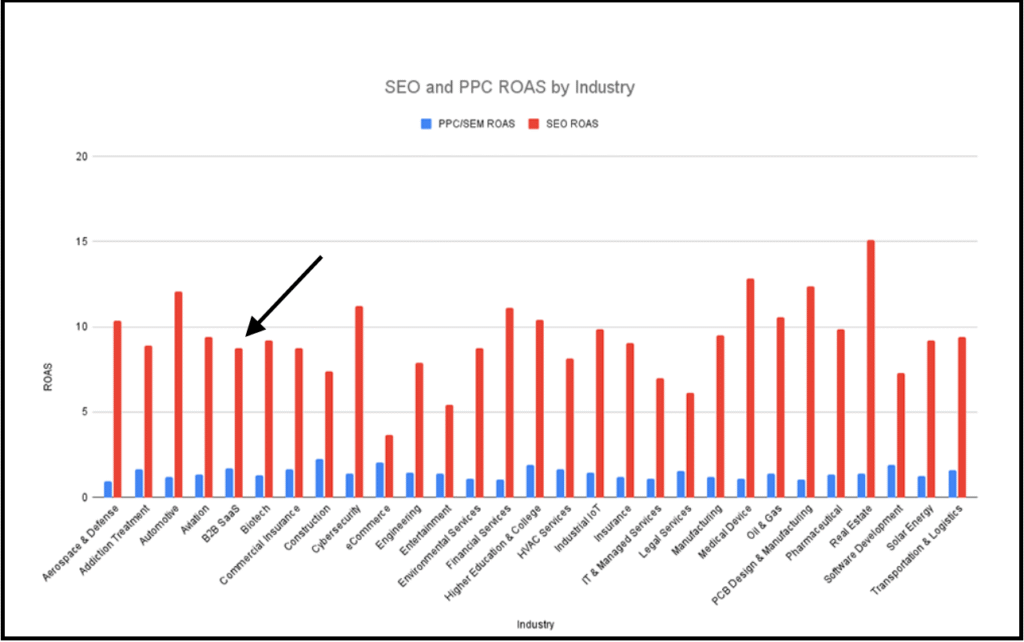
- Build long-term authority
Each optimized page becomes an owned, compounding asset that strengthens your brand’s visibility and credibility. Over time, this authority helps you outrank competitors and build a moat around your niche.
- Improve discoverability across all funnel stages
SEO ensures your brand shows up at every touchpoint of the buyer journey: awareness (TOFU), consideration (MOFU), and conversion (BOFU). This consistency helps move users naturally from interest to intent to purchase.
- Boost organic signups and demos
In one SaaS case study, “book a demo” conversions increased 12×, and over 55% of demo bookings came directly from organic search.

That kind of impact highlights why SEO isn’t just a visibility play but a conversion engine. By targeting use-case–driven keywords and pairing them with optimized landing pages, you can turn organic discovery into predictable, sales-ready demand.
- Stay visible in AI-driven search
With AI summaries and search generative experience (SGE) reshaping SERPs, visibility now depends on being recognized as a credible, authoritative source. Brands that invest in expert-led, context-rich content are far more likely to be cited and clicked.
The Core Strategy of SaaS SEO in 2026
The foundation of a scalable SaaS SEO strategy lies in aligning your content, keyword mapping, and link-building with how your ideal users actually search, evaluate, and buy.
Take Supademo, an interactive demo platform for SaaS companies. The brand scaled its organic traffic from 1K to 35K monthly visits in under two years using the same principles.
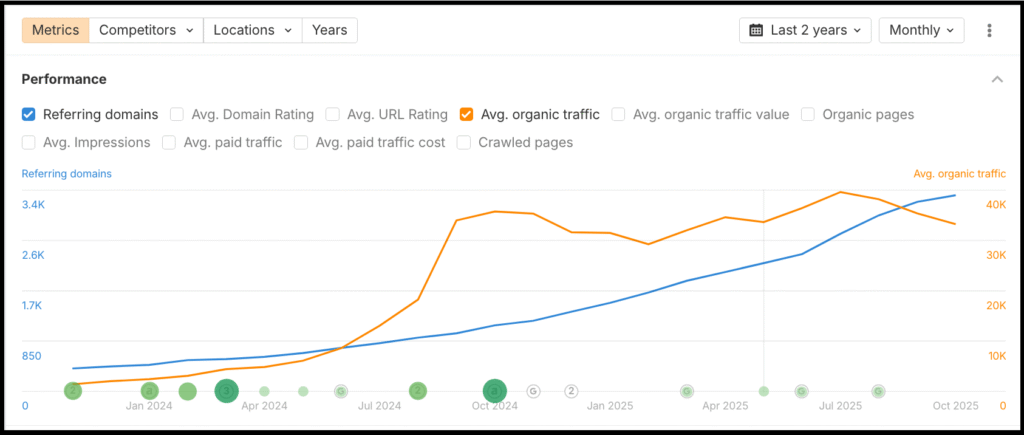
I’m not highlighting a decade-old SaaS giant here because their domain authority and historical backlinks make replication unrealistic. Supademo’s growth, however, proves that even a newer brand can achieve remarkable traction with a well-structured keyword strategy, intent-led content, and consistent, quality link-building.
Now, let’s break down how you can replicate this approach.
1. Plan a keyword strategy that reflects the buyer journey
A scalable SaaS SEO strategy begins with one core principle: understanding how search intent maps to your buyer journey.
Every query a user types reveals where they are in the funnel – whether they’re just discovering solutions, weighing options, or ready to make a purchase. Meeting users at the right stage builds trust and guides them naturally toward conversion.
Let’s understand this with examples:
- TOFU (Top of Funnel)
Keywords like “interactive demo” or “how to insert a table in Canva” target users exploring ways to improve product storytelling.
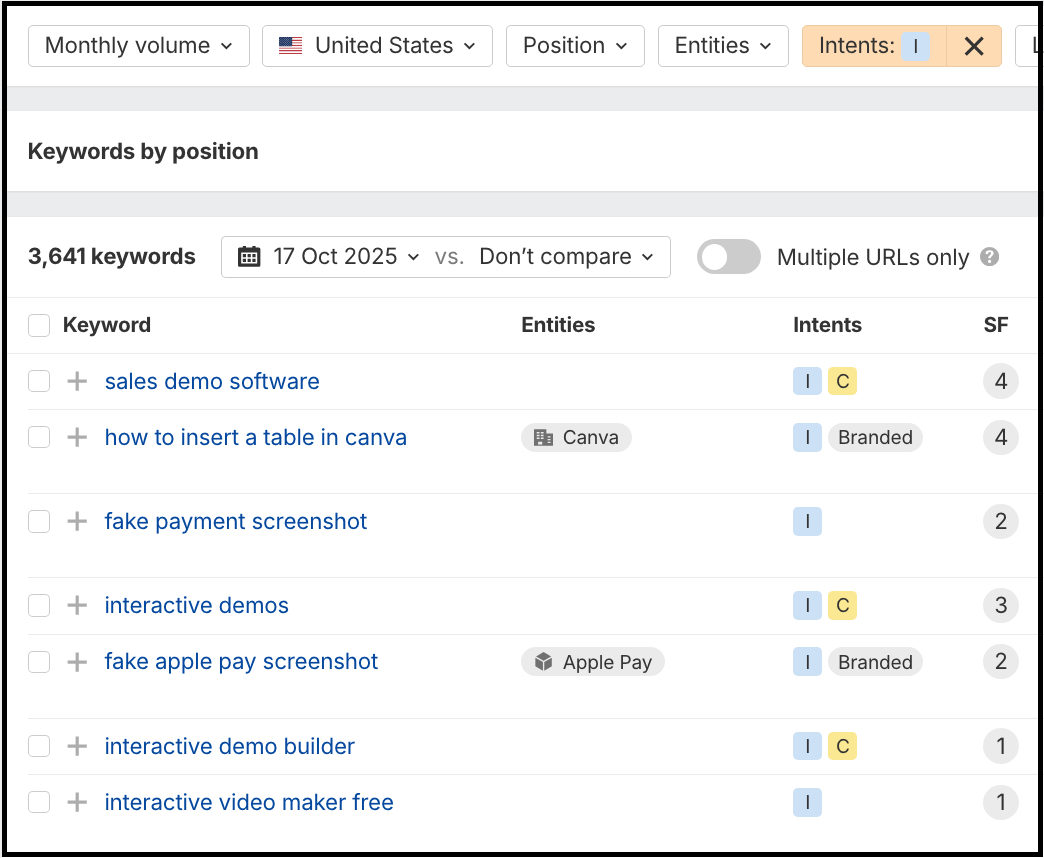
These keywords are primarily informational, focusing on broader topics and user questions rather than your product specifically.
- MOFU (Middle of Funnel)
Queries such as “interactive demo software” or “<competitor> pricing” reach users actively evaluating solutions or comparing tools. This is your chance to showcase features, integrations, and real-world use cases.

These keywords are generally evaluative or comparison-focused, helping users actively consider your product alongside alternatives.
- BOFU (Bottom of Funnel)
Searches like “Supademo pricing” or “Supademo free trial” signal high intent. Optimizing for these terms helps convert visitors who are ready to take action, such as booking a demo or starting a trial.
These keywords typically indicate transactional or navigational intent and directly reference your product.
Currently, Supademo has limited visibility around these bottom-funnel search terms, which presents a strong opportunity to capture users at the final decision stage.
Optimizing keywords for the LLM era
In 2026, effective keyword research for SaaS companies goes beyond traditional search engine optimization. You also need to ensure your brand and content are understood and referenced by large language models (LLMs) like ChatGPT, Google SGE, and Perplexity.
To improve AI search visibility, focus on:
- Emphasizing long-tail queries: Users interact with AI systems conversationally, often asking highly specific questions. By targeting long-tail keywords, your content reflects the way people speak and think, increasing the likelihood that LLMs will surface your brand as a relevant answer.
- Prioritizing BOFU keywords: When users are ready to take action, they seek detailed, solution-oriented guidance. Optimizing for BOFU terms ensures your sales pages, product FAQs, and demos provide precise information that drives conversions.
2. Create content that converts (not just ranks)
In SaaS SEO, ranking for keywords is just the first step. The real impact comes from content that engages, educates, and guides prospects through the buyer journey, ultimately driving conversions.
Every piece of content should align with the user’s intent and funnel stage.
Here’s how to think about SEO content strategy for SaaS:
2.1 Create educational content for TOFU audiences
Educational content helps prospects discover solutions and understand their challenges. Blog posts, guides, and how-to articles that inform and build awareness are perfect for TOFU users.
Think of this as a mentorship moment. Your content should teach first, sell second. Instead of pitching your product right away, help your audience learn something meaningful about your space.
This builds trust, positions your brand as an authority, and encourages users to come back for more guidance.
Supademo has created a variety of educational content that drove significant traffic by answering real user questions in depth.
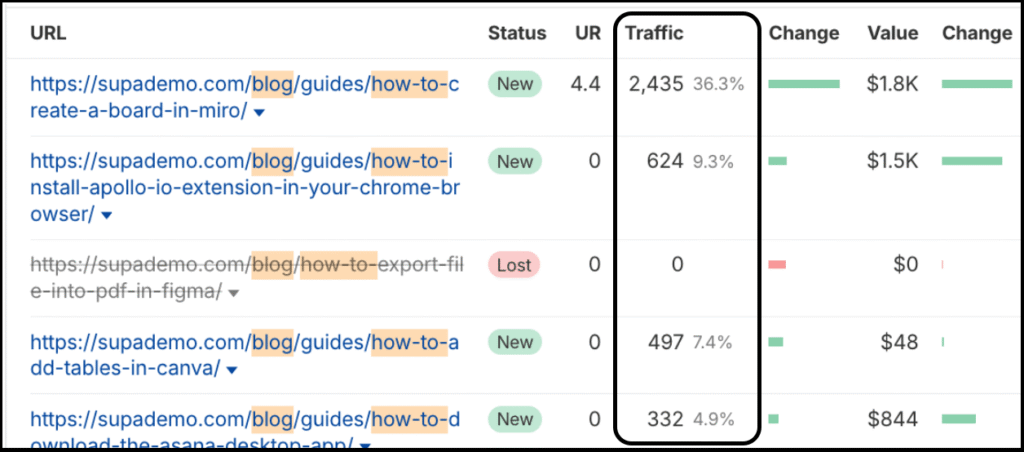
By consistently providing actionable insights, these resources attract users at the early stages of the buyer journey. It helps establish Supademo as a go-to solution provider, even before the product is introduced.
2.2 Create product-led content for MOFU audiences
Middle-of-funnel users are evaluating solutions. This is where you showcase your product in action.
Product-led content includes tutorials, walkthroughs, and feature highlights that demonstrate value, integrations, and differentiators.
Here’s an example from the Supademo blog, “How to create a Miro board.” Notice how the blog subtly integrates the product:
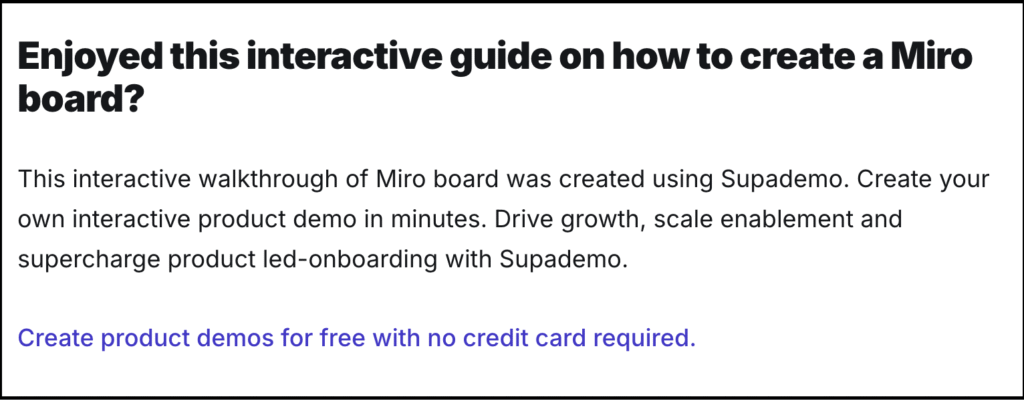
The content educates users while naturally introducing the product, making it easy for prospects to imagine using it themselves, without a pushy sales pitch.
You can also create “<tool name> alternative” pages, a helpful resource for prospects actively comparing different options.
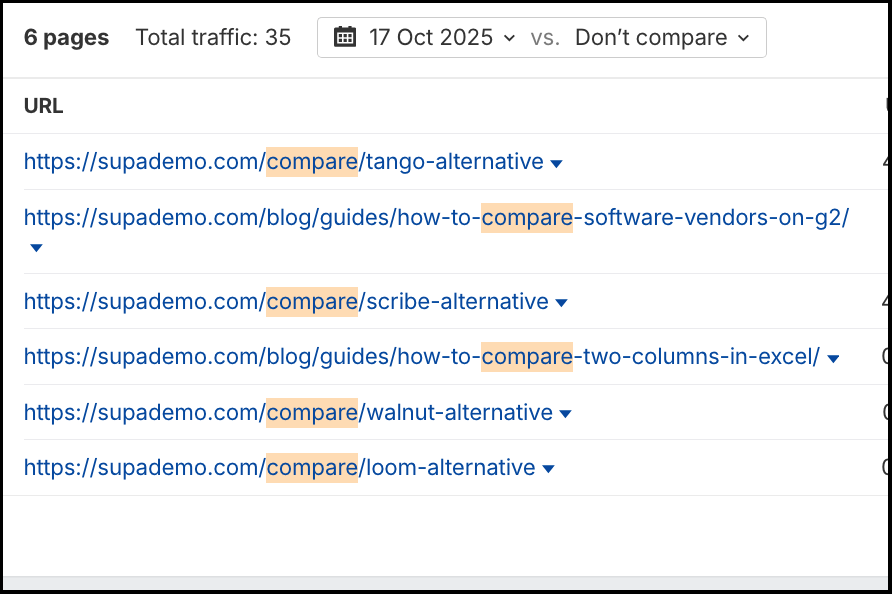
These comparison pages highlight your product’s strengths while addressing common questions and concerns, guiding users toward your solution.
2.3 Create sales pages and FAQs for BOFU audiences
Bottom-of-funnel users are ready to make a decision. BOFU-focused content should remove friction and answer final questions. This includes:
- Clear, persuasive sales pages that outline pricing, features, and benefits.
A strong sales page does more than list features; it tells a story of value, showing how your product solves real problems.
Break down each feature with benefits, highlight differentiators, and make it easy for users to understand what they get and why it matters.
A single Supademo product page is driving 13.2k organic traffic alone.

- FAQs or support pages that address common objections or uncertainties.
FAQs help remove hesitation at the final decision stage. Anticipate questions about pricing, implementation, integrations, or support, and answer them concisely.
This reassures users, builds confidence, and makes the path to conversion smoother.
2.4 Experiment with different formats
You can create case studies to showcase real results and build credibility and trust. Highlight how clients solved specific problems with your solution.
See how Supademo has listed numerous case studies as examples of successful implementation.
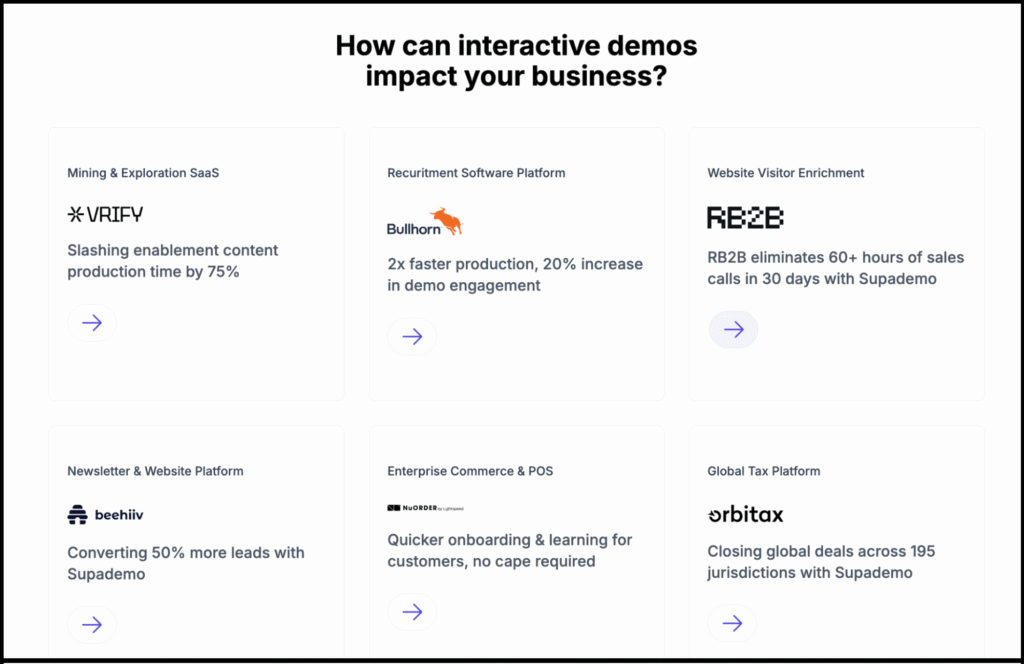
Similarly, other interactive or multimedia content, such as videos, webinars, calculators, quizzes, and interactive demos, engages users across all funnel stages.
By mixing content formats and aligning them to user intent and funnel stage, your SaaS SEO strategy drives traffic, guides prospects, and generates measurable growth.
3. Optimize Technical and On-Page SEO for SaaS
Scalable SaaS SEO depends on your website’s clean architecture and user-first design. Think of technical SEO as the foundation that supports everything else.
Without it, even the best content can’t reach its full potential.
Here are a few fundamentals of SEO to take care of:
- Logical site architecture: Ensure your website is structured for scalability. Organize content by features, use cases, and resources to facilitate easy navigation and future growth.
- Fast loading speed & core web vitals optimization: Prioritize speed and performance. A fast website not only improves user experience but also boosts search engine rankings.
- Schema markup for AI visibility: Implement structured data like Product, FAQ, and HowTo schemas to enhance visibility in AI-driven search results, such as Google’s SGE.
- Internal linking: Strengthen topical clusters by linking related content, helping both users and search engines discover more of your valuable content.
- Consistent on-page optimization: regularly update title tags, meta descriptions, headers, and alt text to align with current SEO best practices.
Supademo has achieved $45.2K in monthly organic traffic value by optimizing its website’s architecture and content.
Why it matters
Technical SEO ensures that search engines can crawl and index your site efficiently, while on-page SEO makes your content relevant and accessible to users. Together, they create a seamless experience that drives visibility, engagement, and conversions.
4. Build high-quality backlinks to scale authority
While algorithms have evolved to understand context and content depth, they still rely on quality backlinks to identify which brands are worth surfacing and referencing.
At Tanot Solutions, we take a white-hat, strategy-backed approach to link building: focusing on relevance, authority, and long-term growth rather than vanity metrics. Every backlink we secure is vetted for contextual fit, domain quality, and alignment with your SEO goals.
Here are three backlink types that help SaaS brands like Supademo scale authority effectively:
Contextual backlinks
These come from editorial placements within relevant articles. They carry strong SEO value because they appear naturally within high-quality content that’s topically aligned with your niche.
For instance, when Supademo is mentioned in a blog about “interactive demo,” it reinforces its authority in that space.

Contextual backlinks not only improve rankings but also drive qualified referral traffic from audiences genuinely interested in your solution.
Listicle mentions
Consistent inclusion in niche-relevant lists can help your product earn repeat visibility across multiple discovery channels, from search to AI-generated recommendations.
In the case of Supademo, being featured in curated posts like “Best Storylane Alternatives” or “Best Interactive Video Software” positions your brand alongside credible peers.
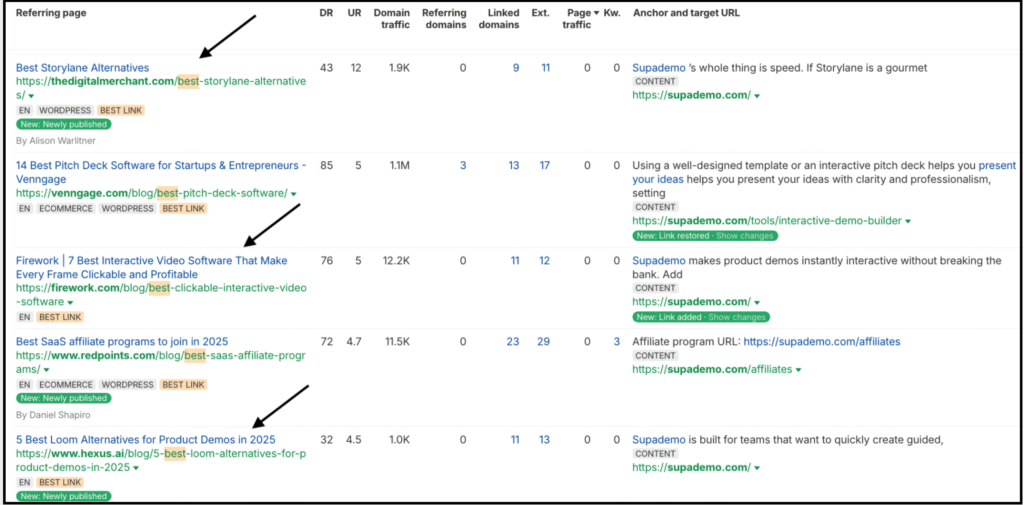
These placements often attract mid-funnel users actively comparing solutions, making them a valuable source of both traffic and trust.
Brand mentions
Earning organic mentions from reputable publishers, review sites, or partner blogs strengthens your credibility, even if they don’t include a direct backlink. Google and LLMs both use these signals to assess a brand’s authority and reputation.

Over time, a strong profile of brand mentions builds entity recognition, helping your company appear in AI-generated summaries and product recommendations.
A few other effective ways to gain high-quality backlinks include creating original images, infographics, research reports, or data-driven assets that other websites naturally want to cite. Visual or data-based content often attracts organic backlinks without outreach, as it provides unique value and credibility to publishers.
How Link Building Fuels SaaS Growth
Link building plays a crucial role in shaping a SaaS company’s organic growth trajectory. A strong correlation exists between a website’s Domain Rating (DR), the number of referring domains, and its Monthly Recurring Revenue (MRR).
As your backlink profile strengthens, search engines view your domain as more credible and authoritative. This leads to higher keyword rankings, improved visibility, and consistent inbound traffic – all key drivers of long-term MRR growth.
In SaaS, that kind of visibility directly translates into greater lead flow and stronger customer acquisition through organic search.
However, how those backlinks are built determines whether that growth is sustainable or short-lived.
- White-hat link building, like the approach Tanot Solutions follows, focuses on ethical, relevance-driven strategies: contextual placements, editorial mentions, and digital PR. These links compound over time, steadily strengthening authority and rankings.
- Risky methods such as PBN links, paid spammy placements, or link swaps might create quick results but often lead to algorithmic penalties or traffic drops that damage long-term visibility.
| Tanot Solutions recently helped a resume building software brand overcome stagnating growth through a white-hat, strategy-backed link-building campaign. The results were significant: Built 250+ high-quality links over 14 months, Drove 400k+ in organic traffic, Improved 35K+ new keywords ranking to #10. Secured 6K+ AI citations across Google AI overviews, ChatGPT and other LLMs. |
5. Measure and Optimize Your SaaS SEO Performance
You can’t improve what you don’t measure. A scalable SaaS SEO strategy depends on tracking the right metrics: the ones that move MRR, not just vanity traffic numbers.
Here are key performance metrics to monitor regularly:
- Organic signups or demo conversions: Track how many users sign up or request demos through organic channels. These conversions directly tie SEO performance to business outcomes.
- Keyword ranking movement: Measure ranking shifts for your priority keywords across TOFU, MOFU, and BOFU stages. Steady upward trends indicate growing topical authority and improved visibility.
- Organic traffic by intent stage: Segment traffic by funnel stage, including educational, evaluative, and transactional, to understand which type of content drives the most qualified visitors.
- Authority growth (DR, referring domains): Use tools like Ahrefs and Semrush to track your DR and referring domains. Consistent growth here signals stronger trust signals and long-term SEO momentum.
- Assisted conversions from SEO: In Google Analytics, review how organic traffic contributes to assisted conversions. SEO often influences signups indirectly, through multiple touchpoints before conversion.
- AI and LLM visibility: As platforms like ChatGPT, Perplexity, and Google SGE influence search, track how often your brand appears in AI-generated results. Tools like SE Rankings and Surfer AI Tracker help measure your content’s reach in conversational and generative search.
| 💡 Tip: SaaS SEO success compounds. Track the metrics that influence recurring revenue and user acquisition, not just traffic spikes. |
Build Long-Term Authority with the Right SEO Partner
Most SaaS SEO efforts fail because they rely on disjointed tactics such as a few blog posts here, a backlink or two there, without strategic alignment.
At Tanot Solutions, we help you connect the dots:
- Strategy-backed link building aligned with your funnel
- White-hat transparency (you approve every link)
- Scalable growth systems that build authority and ROI
When your SaaS SEO strategy is built on trust, strategy, and precision, growth becomes predictable and not accidental.
If you are ready to turn your SEO into a revenue engine, partner with Tanot Solutions and let’s build the authority your SaaS brand deserves.
Frequently Asked Questions (FAQs)
How much does SaaS SEO typically cost for startups or growing teams?
SaaS SEO pricing can range from $2,000 to $15,000 per month, depending on your goals, niche, and competition. Startups often begin with basic content and technical optimization, while growing teams may invest in ongoing link building and funnel-based strategies. Some agencies offer fixed retainers, while others use performance-based models. Always request a detailed scope of work so you know what’s included, especially if you’re targeting high-ROI pages like demos and pricing.
What’s the difference between SaaS SEO and traditional B2B SEO?
SaaS SEO focuses on user intent across the buyer journey from awareness to product trials. Unlike traditional B2B SEO, which might target broad industry terms or lead gen forms, SaaS SEO often involves ranking for product features, use cases, onboarding queries, and pricing pages. It also includes more attention to product-led content and BOFU (bottom-of-funnel) queries like “[tool name] alternative” or “how to use [feature].” SaaS companies rely on recurring revenue, so SEO efforts are designed not only to attract users but also to support conversion and retention.
How long does it take for SaaS SEO to show measurable results?
SaaS SEO typically takes 3 to 6 months to show initial traction, depending on your domain authority, content quality, and competition. If your site is new or has minimal backlinks, expect the timeline to lean toward the longer end. Early wins usually come from low-competition, long-tail keywords and technical optimizations. More competitive keywords and BOFU pages often take 6+ months to rank well. Tracking demo bookings, sign-ups, or assisted conversions alongside rankings will give you a more accurate picture of progress.
What types of backlinks work best for SaaS companies?
The most effective backlinks for SaaS come from editorial placements, product listicles, and niche blogs. Links from pages that cover your use case or compare tools in your category tend to drive both traffic and authority. Prioritize links that are relevant, natural, and placed within content users actually read, rather than random directories or low-quality sites.
Is technical SEO really important for SaaS websites with just a few pages?
Yes, even lean SaaS sites benefit from solid technical SEO. A small site might still have issues like poor page speed, broken links, or confusing URL structures all of which affect crawlability and rankings. Technical SEO also includes schema markup, which helps your content appear in rich results or AI-powered overviews. Clean architecture, fast loading times, and a logical URL structure also improve the user experience, especially if you’re planning to scale your content in the future. Ignoring technical SEO early can make future fixes more complex and costly.
How do I know if my SaaS content strategy is aligned with the buyer journey?
Check if your content covers all stages of the funnel educational content for awareness, feature-based pages for evaluation, and clear CTAs for conversion. If you’re only ranking for top-of-funnel queries, you might be missing high-intent traffic. A balanced strategy maps keywords and content types to each user stage to drive meaningful engagement and conversions.
What metrics should I track to measure real SaaS SEO performance?
Focus on metrics tied to growth: organic signups, demo requests, assisted conversions, keyword rankings by intent stage, and backlink quality. Don’t rely solely on traffic. Use tools like Google Analytics and Ahrefs to track performance and monitor how SEO contributes to actual revenue or pipeline.


